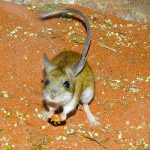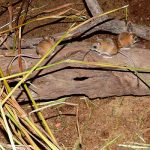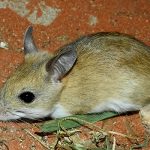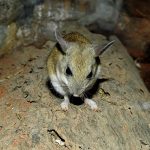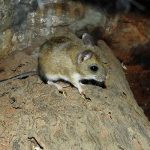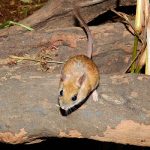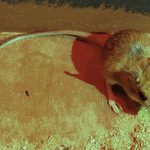SPINIFEX HOPPING MOUSE
The Spinifex hopping mouse is a small nocturnal rodent native to the arid and semi-arid regions of Australia. You’ll find these remarkable mice in environments dominated by spinifex grasses and sandy deserts, spanning across Western Australia, Northern Territory, South Australia, and Queensland. Their habitat is characterised by sparse vegetation and harsh conditions, yet they thrive in these challenging landscapes. These mice have highly efficient kidneys, which conserve water by producing very concentrated urine. This adaptation is vital for surviving in their dry habitats.
Spinifex hopping mice have large hind legs and long tails, which help them to hop efficiently across the desert sands. This mode of locomotion is not only energy-efficient but also allows them to cover large distances in search of food.
They create complex burrow systems with multiple entrances, which provide protection from predators and extreme weather. These burrows can be up to a meter deep and are shared by multiple individuals. This social structure helps them maintain their burrows and provides protection against predators.
Being nocturnal helps them avoid the heat of the day. Their large eyes are adapted for night vision, allowing them to navigate and forage in the dark.
Breeding for the Spinifex hopping mouse is closely tied to rainfall. They tend to breed after significant rain, which ensures there is enough food available for the offspring. A female can give birth to litters of up to five pups, and they can breed multiple times a year if conditions are favourable. The gestation period is around 38 days, and the young are weaned at about four weeks of age. In the wild, these mice typically live for about one to two years, although in captivity, they can live slightly longer.
Spinifex hopping mice are omnivorous, with a diet that includes seeds, leaves, roots, and insects. Their ability to extract moisture from their food is crucial for survival in their arid environment, as water sources are often scarce. They are also known to forage at night, which helps them avoid the extreme daytime temperatures of the desert.
For many Aboriginal communities, the Spinifex hopping mouse holds cultural significance. These mice are often featured in traditional stories and are considered an integral part of the desert ecosystem. Aboriginal knowledge and observations of these animals have contributed greatly to scientific understanding, highlighting the deep connection between Indigenous people and their environment.
While the Spinifex hopping mouse is currently not listed as endangered, their habitat is vulnerable to changes caused by human activity and climate change. Protecting their natural environment is crucial for their continued survival. By understanding and appreciating the unique adaptations and lifestyle of the Spinifex hopping mouse, we can foster a greater appreciation for the delicate balance of life in Australia’s deserts and the importance of conserving these remarkable ecosystems.

